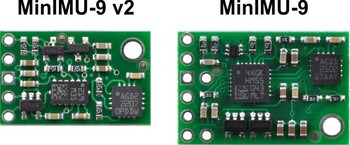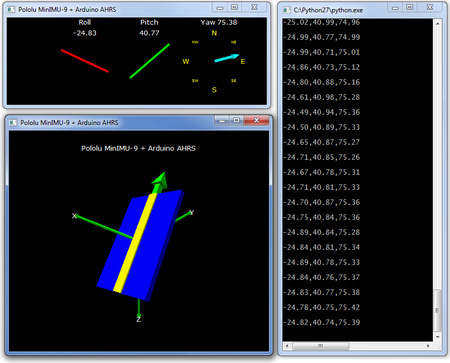Pololu MinIMU-9 v2 Gyro, Accelerometer and Compass (L3GD20 and LSM303DLHC Carrier) - DISCONTINUED
Features and Specifications
- Dimensions: 0.8" x 0.5" x 0.1" (20 x 13 x 3 mm)
- Weight without header pins: 0.7 g (0.02 oz)
- Operating voltage: 2.5 to 5.5 V
- Supply current: 10 mA
- Output format (I²C):
- Gyro: one 16-bit reading per axis
- Accelerometer: one 12-bit reading (left-justified) per axis
- Magnetometer: one 12-bit reading (right-justified) per axis
- Sensitivity range (configurable):
- Gyro: ±250, ±500, or ±2000°/s
- Accelerometer: ±2, ±4, ±8, or ±16 g
- Magnetometer: ±1.3, ±1.9, ±2.5, ±4.0, ±4.7, ±5.6, or ±8.1 gauss
Included Components
A 5 x 1 strip of 0.1" header pins and a 5 x 1 strip of 0.1" right-angle header pins are included, as shown in the picture above. You can solder the header strip of your choice to the board for use with custom cables or solderless breadboards, or you can solder wires directly to the board itself for more compact installations.
The Pololu MinIMU-9 v2 is a compact (0.8" x 0.5") board that combines ST's L3GD20 3-axis gyroscope and LSM303DLHC 3-axis accelerometer and 3-axis magnetometer to form an inertial measurement unit (IMU); we therefore recommend careful reading of the L3GD20 datasheet (2MB pdf) and the LSM303DLHC datasheet (629k pdf) before using this product. These sensors are great Ics, but their small packages make them difficult for the typical student or hobbyist to use. They also operate at voltages below 3.6 V, which can make interfacing difficult for microcontrollers operating at 5 V. The MinIMU-9 v2 addresses these issues by incorporating additional electronics, including a voltage regulator and a level-shifting circuit, while keeping the overall size as compact as possible. The board ships fully populated with its SMD components, including the L3GD20 and LSM303, as shown in the product picture.
The MinIMU-9 v2 offers several enhancements over our original MinIMU-9. Most noticeably, the MinIMU-9 v2 board is 0.1" smaller on each side, reducing its overall size by 25%! Compared to the LSM303DLH and LSM303DLM used on the earlier MinIMU-9 boards, the LSM303DLHC on the MinIMU-9 v2 features improved magnetic sensing resolution and a wider acceleration measurement range (±2g to ±16g). In addition, the new L3GD20 gyro uses a higher resonant frequency that makes it more resistant to audio noise and vibrations than the older L3G4200D. The MinIMU-9 v2 is pin- compatible with the original MinIMU-9, although changes in I²C addresses and configuration registers mean that code written to interface with a MinIMU-9 will need to be modified to work with a MinIMU-9 v2.

The L3GD20 and the LSM303DLHC have many configurable options, including dynamically selectable sensitivities for the gyro, accelerometer, and magnetometer, as well as a choice of output data rates for each sensor. The two Ics can be accessed through a shared I²C/TWI interface, allowing all three sensors to be addressed individually via a single clock line and a single data line. The nine independent rotation, acceleration, and magnetic readings (sometimes called 9DOF) provide all the data needed to make an attitude and heading reference system (AHRS). With an appropriate algorithm, a microcontroller or computer can use the data to calculate the orientation of the MinIMU-9 v2 board; the gyro can be used to very accurately track rotation on a short timescale, while the accelerometer and compass can help compensate for gyro drift over time by providing an absolute frame of reference. The respective axes of the two chips are aligned on the board to facilitate these sensor fusion calculations. (For an example of such a system using an Arduino, see the picture below and the Sample Code section at the bottom of this page.)

The carrier board includes a low-dropout linear voltage regulator that provides the 3.3 V required by the L3GD20 and LSM303, allowing the module to be powered from a single 2.5-5.5 V supply. The regulator output is available on the VDD pin and can supply almost 150 mA to external devices. The breakout board also includes a circuit that shifts the I²C clock and data lines to the same logic voltage level as the supplied VIN, making it simple to interface the board with 5 V systems, and the board's 0.1" Pin spacing makes it easy to use with standard solderless breadboards and 0.1" Perfboards.
Pololu MinIMU-9 v2 Gyro, Accelerometer and Compass (L3GD20 and LSM303DLHC Carrier) - DISCONTINUED
- Product Code: TS-059-000
- Brand: Pololu
- MPN: 1268
- Availability: Discontinued

